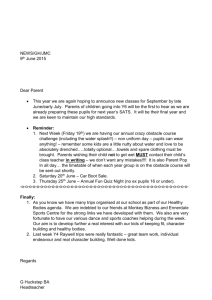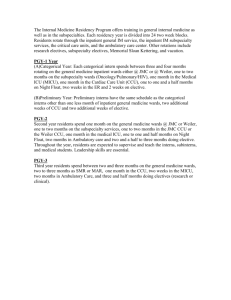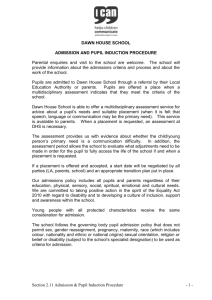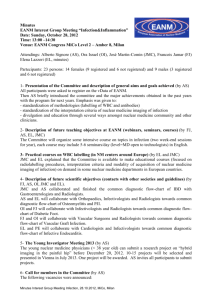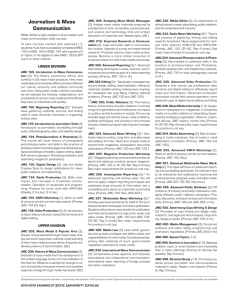structuring-music
advertisement
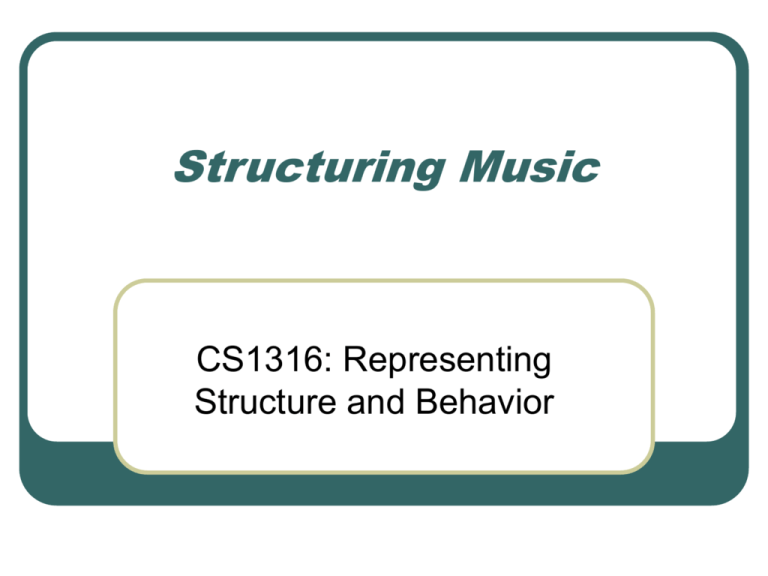
Structuring Music
CS1316: Representing
Structure and Behavior
Story
Using JMusic
•
With multiple Parts and Phrases
Creating music objects for exploring composition
•
•
•
•
Version 1: Using an array for Notes, then scooping them
up into Phrases.
Version 2: Using a linked list of song elements.
Version 3: General song elements and song phrases
• Computing phrases
• Repeating and weaving
Version 4: Creating a tree of song parts, each with its
own instrument.
JMusic: Java Music library
JMusic knows about WAV files and many other
formats, too (e.g., QuickTime)
We’ll use it for manipulating MIDI
•
Musical Instrument Digital Interface, an industrystandard interface used on electronic musical
keyboards and PCs for computer control of musical
instruments and devices.
MIDI is about recording music, not sound.
Creating Notes
JMC=JMusic Constants
Welcome to DrJava.
> import jm.music.data.*
Makes code easier to
> import jm.JMC;
read from a music
> import jm.util.*;
perspective
> Note n = new Note(JMC.C4,JMC.QUARTER_NOTE);
>n
jMusic NOTE: [Pitch = 60][RhythmValue = 1.0][Dynamic = 85][Pan = 0.5][Duration = 0.9]
> JMC.C4
60
> JMC.QUARTER_NOTE
1.0
> JMC.QN
1.0
> Note n2 = new Note(64,2.0);
> n2
jMusic NOTE: [Pitch = 64][RhythmValue = 2.0][Dynamic = 85][Pan = 0.5][Duration = 1.8]
Creating Phrases
> Phrase phr = new Phrase();
Using notes, or an
array of note pieces.
> phr.addNote(n);
> phr.addNote(n2);
> double [] notes1 = {67, 0.25, 64, 0.5, 60, 1.0}
> phr.addNoteList(notes1)
> double [] notes2 = {JMC.G4,JMC.QN, JMC.E4,
JMC.EN, JMC.C4, JMC.WN}
> phr.addNoteList(notes2)
Viewing Phrases
> View.notate(phr)
From Viewer: Manipulate and
MIDI
Can save or open
MIDI files
Can change key or
time signature.
Other tools allow
changing other
characteristics, like
tempo.
Different ways of creating
Phrases
> Phrase phr2 = new
Phrase("Phrase
2",4.0,JMC.FLUTE);
> phr2.addNoteList(notes2)
A Phrase that starts later
> Phrase phr2 = new Phrase("Phrase
2",4.0,JMC.FLUTE);
> phr2.addNoteList(notes2)
> View.notate(phr2)
Adding parts into phrases
(Wrong way first)
> Part part1 = new Part();
> part1.addPhrase(phr);
> part1.addPhrase(phr2);
> View.notate(part1);
Kinda lost the
phrase
distinctions.
Building Parts and Scores
> Part partA = new Part("Part A",JMC.PIANO,1)
> partA.addPhrase(phr);
> Part partB = new Part("Part B",JMC.SAX,2)
> partB.addPhrase(phr2);
> Score score1 = new Score("My Two Part
Score");
> score1.addPart(partA);
> score1.addPart(partB);
Viewing the Score
> View.notate(score1);
Amazing
Grace
import jm.music.data.*;
import jm.JMC;
import jm.util.*;
import jm.music.tools.*;
public class AmazingGraceSong {
private Score myScore = new Score("Amazing Grace");
public void fillMeUp(){
myScore.setTimeSignature(3,4);
double[] phrase1data =
{JMC.G4, JMC.QN,
JMC.C5, JMC.HN, JMC.E5,JMC.EN, JMC.C5,JMC.EN,
JMC.E5,JMC.HN,JMC.D5,JMC.QN,
JMC.C5,JMC.HN,JMC.A4,JMC.QN,
JMC.G4,JMC.HN,JMC.G4,JMC.EN,JMC.A4,JMC.EN,
JMC.C5,JMC.HN,JMC.E5,JMC.EN,JMC.C5,JMC.EN,
JMC.E5,JMC.HN,JMC.D5,JMC.EN,JMC.E5,JMC.EN,
JMC.G5,JMC.DHN};
double[] phrase2data =
{JMC.G5,JMC.HN,JMC.E5,JMC.EN,JMC.G5,JMC.EN,
JMC.G5,JMC.HN,JMC.E5,JMC.EN,JMC.C5,JMC.EN,
JMC.E5,JMC.HN,JMC.D5,JMC.QN,
JMC.C5,JMC.HN,JMC.A4,JMC.QN,
JMC.G4,JMC.HN,JMC.G4,JMC.EN,JMC.A4,JMC.EN,
JMC.C5,JMC.HN,JMC.E5,JMC.EN,JMC.C5,JMC.EN,
JMC.E5,JMC.HN,JMC.D5,JMC.QN,
JMC.C5,JMC.DHN
};
Phrase myPhrase = new Phrase();
myPhrase.addNoteList(phrase1data);
myPhrase.addNoteList(phrase2data);
// create a new part and add the phrase to it
Part aPart = new Part("Parts",
JMC.FLUTE, 1);
aPart.addPhrase(myPhrase);
// add the part to the score
myScore.addPart(aPart);
> AmazingGraceSong song1 =
new AmazingGraceSong();
> song1.fillMeUp();
> song1.showMe();
};
public void showMe(){
View.notate(myScore);
};
}
Imports and some private data
import jm.music.data.*;
import jm.JMC;
import jm.util.*;
import jm.music.tools.*;
public class AmazingGraceSong {
private Score myScore = new Score("Amazing
Grace");
myScore is private instance data
public void fillMeUp(){
myScore.setTimeSignature(3,4);
Filling the
Score
Each array is note,
duration, note,
duration, note,
duration, etc.
I broke it roughly
into halves.
double[] phrase1data =
{JMC.G4, JMC.QN,
JMC.C5, JMC.HN, JMC.E5,JMC.EN, JMC.C5,JMC.EN,
JMC.E5,JMC.HN,JMC.D5,JMC.QN,
JMC.C5,JMC.HN,JMC.A4,JMC.QN,
JMC.G4,JMC.HN,JMC.G4,JMC.EN,JMC.A4,JMC.EN,
JMC.C5,JMC.HN,JMC.E5,JMC.EN,JMC.C5,JMC.EN,
JMC.E5,JMC.HN,JMC.D5,JMC.EN,JMC.E5,JMC.EN,
JMC.G5,JMC.DHN};
double[] phrase2data =
{JMC.G5,JMC.HN,JMC.E5,JMC.EN,JMC.G5,JMC.EN,
JMC.G5,JMC.HN,JMC.E5,JMC.EN,JMC.C5,JMC.EN,
JMC.E5,JMC.HN,JMC.D5,JMC.QN,
JMC.C5,JMC.HN,JMC.A4,JMC.QN,
JMC.G4,JMC.HN,JMC.G4,JMC.EN,JMC.A4,JMC.EN,
JMC.C5,JMC.HN,JMC.E5,JMC.EN,JMC.C5,JMC.EN,
JMC.E5,JMC.HN,JMC.D5,JMC.QN,
JMC.C5,JMC.DHN
};
Phrase myPhrase = new Phrase();
myPhrase.addNoteList(phrase1data);
myPhrase.addNoteList(phrase2data);
// create a new part and add the phrase to it
Part aPart = new Part("Parts",
JMC.FLUTE, 1);
aPart.addPhrase(myPhrase);
// add the part to the score
myScore.addPart(aPart);
};
Showing the Score
public void showMe(){
View.notate(myScore);
};
The Organization of JMusic
Objects
Score: timeSignature, tempo, &
Part: Instrument &
Part: Instrument &
Phrase: startingTime &
Note
(pitch,duration)
Note
(pitch,duration)
Note
(pitch,duration)
Phrase: startingTime &
Note
(pitch,duration)
Note
(pitch,duration)
Thought Experiment
How are they doing that?
How can there be any number of Notes
in a Phrase, Phrases in a Part, and Parts
in a Score?
• (Hint: They ain’t usin’ arrays!)
How do we explore composition
here?
We want to quickly and easily throw
together notes in different groupings and
see how they sound.
The current JMusic structure models
music.
• Let’s try to create a structure that models
thinking about music as bunches of
riffs/SongElements that we want to combine
in different ways.
Version 1: Notes in an array
Let’s just put notes of interest (for now,
just random) in an array.
We’ll traverse the array to gather the
notes up into a Phrase, then use View to
notate the Phrase.
Using an array to structure
Notes
> Note [] someNotes = new Note[100];
> for (int i = 0; i < 100; i++)
{someNotes[i]= new Note((int)
(128*Math.random()),0.25);}
> // Now, traverse the array and gather them up.
> Phrase myphrase = new Phrase()
> for (int i=0; i<100; i++)
{myphrase.addNote(someNotes[i]);}
> View.notate(myphrase);
Critique of Version 1
So where’s the music?
• 100 random notes isn’t the issue.
• It’s that we don’t think about notes as just one
long strand.
Where are the phrases/riffs/elements?
How do we explore patterns like this?
• We just have one long line of notes.
• insertAfter and delete are just as hard here as
in sampled sounds!
Version 2: Using a linked list of
song elements
Let’s re-think Amazing Grace as a
collection of elements that we can
shuffle around as we’d like.
We can make any element follow any
other element.
What’s in each element?
AmazingGraceSongElement
It KNOWS: it’s Part and what comes
next
It CAN DO: filling itself from the first
or second phrase (with a given start
time and instrument), setting the next
one, getting the next one, and
showing (notating) myself and all
others.
What that would look like to use
it
Welcome to DrJava.
> import jm.JMC;
> AmazingGraceSongElement2 part1 = new
AmazingGraceSongElement2();
> part1.setPhrase(part1.phrase1(),0.0,JMC.FLUTE);
> AmazingGraceSongElement2 part2 = new
AmazingGraceSongElement2();
> part1.getEndTime()
22.0
> part2.setPhrase(part2.phrase2(),22.0,JMC.PIANO);
> part1.setNext(part2);
> part1.showFromMeOn();
Part1.showFromMeOn()
What’s going on here?
AmazingGraceSongElement part1
AmazingGraceSongElement part2
myPart: Filled with
phrase1(flute))
myPart: Filled with
phrase2(piano)
next: part2
next: null
Adding a third part
> AmazingGraceSongElement2 part3 =
new AmazingGraceSongElement2();
> part3.setPhrase(part3.phrase1(),0.0,
JMC.TRUMPET);
> part1.setNext(part3);
> part3.setNext(part2);
> part1.showFromMeOn();
part1.showFromMeOn();
Now has three parts
What’s going on here?
AmazingGraceSongElement part1
AmazingGraceSongElement part2
myPart: Filled with phrase1
(flute)
myPart: Filled with phrase2
(piano)
next: part3
next: null
AmazingGraceSongElement part3
myPart: Filled with phrase1
(trumpet)
next: part2
Introducing the Linked List
A linked list is information broken into
smaller pieces, where each piece knows
the next piece, but none other.
Another example of a linked list
Non-linear video
editing (like in iMovie)
•
•
You have a collection of
video clips (information)
You drag them into a
timeline.
• Each clip still doesn’t
know all clips, but it
knows the next one.
Why use linked lists versus
arrays?
Just two reasons now, more later:
1. Can grow to any size (well, as long as
memory permits)
•
Just create a new element and poke it into the
list.
2. MUCH easier to insert!
•
Look at how easily we put part3 between part1
and part2.
Implementing
AmazingGraceSongElement2
import jm.music.data.*;
import jm.JMC;
import jm.util.*;
import jm.music.tools.*;
public class AmazingGraceSongElement2 {
// Every element knows its next element and its
part (of the score)
private AmazingGraceSongElement2 next;
private Part myPart;
It’s considered good form to
make your object’s data private
unless you need to make it
public.
Our Constructor
// When we make a new element, the next
part is empty, and ours is a blank new
part
public AmazingGraceSongElement2(){
this.next = null;
this.myPart = new Part();
}
What setPhrase does
// setPhrase takes a phrase and makes it the one for this element
// at the desired start time with the given instrument
public void setPhrase(Phrase myPhrase, double startTime, int
instrument) {
//Phrases get returned from phrase1() and phrase2() with
default (0.0) startTime
// We can set it here with whatever setPhrase gets as input
myPhrase.setStartTime(startTime);
this.myPart.addPhrase(myPhrase);
this.myPart.setInstrument(instrument);
}
Don’t get hung up on these
details—this is just
manipulating the JMusic
classes so that we can store
the information we want.
The Phrases
static public Phrase phrase1() {
static public Phrase phrase2() {
double[] phrase1data =
{JMC.G4, JMC.QN,
JMC.C5, JMC.HN, JMC.E5,JMC.EN,
JMC.C5,JMC.EN,
JMC.E5,JMC.HN,JMC.D5,JMC.QN,
JMC.C5,JMC.HN,JMC.A4,JMC.QN,
JMC.G4,JMC.HN,JMC.G4,JMC.EN,JMC.A4,JMC.EN,
JMC.C5,JMC.HN,JMC.E5,JMC.EN,JMC.C5,JMC.EN,
JMC.E5,JMC.HN,JMC.D5,JMC.EN,JMC.E5,JMC.EN,
JMC.G5,JMC.DHN};
double[] phrase2data =
{JMC.G5,JMC.HN,JMC.E5,JMC.EN,JMC.G5,JMC.EN,
JMC.G5,JMC.HN,JMC.E5,JMC.EN,JMC.C5,JMC.EN,
JMC.E5,JMC.HN,JMC.D5,JMC.QN,
JMC.C5,JMC.HN,JMC.A4,JMC.QN,
JMC.G4,JMC.HN,JMC.G4,JMC.EN,JMC.A4,JMC.EN,
JMC.C5,JMC.HN,JMC.E5,JMC.EN,JMC.C5,JMC.EN,
JMC.E5,JMC.HN,JMC.D5,JMC.QN,
JMC.C5,JMC.DHN
};
Phrase myPhrase = new Phrase();
myPhrase.addNoteList(phrase1data);
return myPhrase;
Phrase myPhrase = new Phrase();
myPhrase.addNoteList(phrase2data);
return myPhrase;
}
}
Static? This means that we can
actually access them without any
instances. Is that useful here?
Well, not yet…
Handling the linked list
// Here are the two methods needed to make a linked list of
elements
public void setNext(AmazingGraceSongElement2
nextOne){
this.next = nextOne;
}
public AmazingGraceSongElement2 next(){
return this.next;
}
Controlling access:
An accessor method
// We could just access myPart directly
// but we can CONTROL access by using
a method
// (called an accessor)
private Part part(){
return this.myPart;
}
A little object manipulation
// Why do we need this?
// If we want one piece to start after another, we need
// to know when the last one ends.
// Notice: It's the phrase that knows the end time.
// We have to ask the part for its phrase (assuming only
one)
// to get the end time.
public double getEndTime(){
return this.myPart.getPhrase(0).getEndTime();
}
showFromMeOn()
public void showFromMeOn(){
// Make the score that we'll assemble the elements into
// We'll set it up with the time signature and tempo we like
Score myScore = new Score("Amazing Grace");
myScore.setTimeSignature(3,4);
myScore.setTempo(120.0);
// Each element will be in its own channel
int channelCount = 1;
// Start from this element (this)
AmazingGraceSongElement2 current = this;
// While we're not through...
while (current != null)
{
// Set the channel, increment the channel, then add it in.
current.setChannel(channelCount);
channelCount = channelCount + 1;
myScore.addPart(current.part());
This is called traversing
the linked list.
// Now, move on to the next element
current = current.next();
};
// At the end, let's see it!
View.notate(myScore);
}
The Key Part
// Start from this element (this)
AmazingGraceSongElement2 current = this;
// While we're not through...
while (current != null)
{
// Set the channel, increment the channel, then add it in.
//BLAH BLAH BLAH (Ignore this part for now)
// Now, move on to the next element
current = current.next();
};
// At the end, let's see it!
View.notate(myScore);
Step 1:
// Start from this element (this)
AmazingGraceSongElement2 current = this;
AmazingGraceSongElement part1
AmazingGraceSongElement part2
myPart: Filled with phrase1
(flute)
myPart: Filled with phrase2
(piano)
next: part3
next: null
current
AmazingGraceSongElement part3
myPart: Filled with phrase1
(trumpet)
next: part2
Step 2:
// While we're not through...
while (current != null)
{ //BLAH BLAH BLAH – PROCESS THIS PART
AmazingGraceSongElement part1
AmazingGraceSongElement part2
myPart: Filled with phrase1
(flute)
myPart: Filled with phrase2
(piano)
next: part3
next: null
current
AmazingGraceSongElement part3
myPart: Filled with phrase1
(trumpet)
next: part2
Step 3:
// Now, move on to the next element
current = current.next();
};
AmazingGraceSongElement part1
AmazingGraceSongElement part2
myPart: Filled with phrase1
(flute)
myPart: Filled with phrase2
(piano)
next: part3
next: null
AmazingGraceSongElement part3
myPart: Filled with phrase1
(trumpet)
next: part2
current
Step 4:
// While we're not through...
while (current != null)
{ //BLAH BLAH BLAH – PROCESS THIS PART
AmazingGraceSongElement part1
AmazingGraceSongElement part2
myPart: Filled with phrase1
(flute)
myPart: Filled with phrase2
(piano)
next: part3
next: null
AmazingGraceSongElement part3
myPart: Filled with phrase1
(trumpet)
next: part2
current
Step 5:
// Now, move on to the next element
current = current.next();
};
AmazingGraceSongElement part1
AmazingGraceSongElement part2
myPart: Filled with phrase1
(flute)
myPart: Filled with phrase2
(piano)
next: part3
next: null
AmazingGraceSongElement part3
myPart: Filled with phrase1
(trumpet)
next: part2
current
Step 6:
// While we're not through...
while (current != null)
{ //BLAH BLAH BLAH – PROCESS THIS PART
AmazingGraceSongElement part1
AmazingGraceSongElement part2
myPart: Filled with phrase1
(flute)
myPart: Filled with phrase2
(piano)
next: part3
next: null
AmazingGraceSongElement part3
myPart: Filled with phrase1
(trumpet)
next: part2
current
Step 7:
// Now, move on to the next element
current = current.next();
};
AmazingGraceSongElement part1
AmazingGraceSongElement part2
myPart: Filled with phrase1
(flute)
myPart: Filled with phrase2
(piano)
next: part3
next: null
AmazingGraceSongElement part3
myPart: Filled with phrase1
(trumpet)
NULL
next: part2
current
Step 8:
// While we're not through...
while (current != null)
AmazingGraceSongElement part1
STOP
THE
LOOP!
AmazingGraceSongElement part2
myPart: Filled with phrase1
(flute)
myPart: Filled with phrase2
(piano)
next: part3
next: null
AmazingGraceSongElement part3
myPart: Filled with phrase1
(trumpet)
NULL
next: part2
current
Traversing arrays vs. lists
//TRAVERSING A LIST
// Start from this element (this)
AmazingGraceSongElement2
current = this;
// While we're not through...
while (current != null)
{
// Set the channel, increment the
channel, then add it in.
//BLAH BLAH BLAH (Ignore this part
for now)
// Now, move on to the next
element
current = current.next();
};
> // Now, traverse the array
and gather them up.
> Phrase myphrase = new
Phrase()
> for (int i=0; i<100; i++)
{myphrase.addNote(
someNotes[i]);}
Inserting into lists
// Here are the two methods
needed to make a linked list
of elements
public void
setNext(AmazingGraceSong
Element2 nextOne){
this.next = nextOne;
}
public
AmazingGraceSongElement
2 next(){
return this.next;
}
> part1.setNext(part3);
> part3.setNext(part2);
> part1.showFromMeOn();
Inserting into arrays
public void insertAfter(Sound inSound, int start){
SoundSample current=null;
// Find how long insound is
int amtToCopy = inSound.getLength();
int endOfThis = this.getLength()-1;
// If too long, copy only as much as will fit
if (start + amtToCopy > endOfThis)
{amtToCopy = endOfThis-start-1;};
// ** First, clear out room.
// Copy from endOfThis-amtToCopy up to endOfThis
for (int i=endOfThis-amtToCopy; i > start ; i--)
{
current = this.getSample(i);
current.setValue(this.getSampleValueAt(i+amtToCopy));
}
//** Second, copy in inSound up to amtToCopy
for (int target=start,source=0;
source < amtToCopy;
target++, source++) {
current = this.getSample(target);
current.setValue(inSound.getSampleValueAt(source));
}
}
> Sound test2 = new
Sound(
"D:/cs1316/MediaSourc
es/thisisatest.wav");
> test.insertAfter(test2,
40000)
> test.play()
More on Arrays vs. Lists
Arrays
•
•
•
Much easier to traverse
Very fast to access a specific (nth) element
But really a pain to insert and delete.
•
•
Hard to write the code
Can take a long time if it’s a big array
Lists
•
•
•
More complex to traverse
Slower to access a specific element
Very easy to insert (and later we’ll see, delete)
•
•
Simple code
Takes no time at all to run
Critique of Version 2
Lovely structuring of data, but just how much
can one do with two parts of Amazing Grace?
•
But what does the ordering mean? What if we
had gone part1->part2->part3 instead?
•
•
We need the ability to have a library of phrases
What should the order encode?
Right now, it encodes nothing.
When we’re exploring music, do we really want
to worry about instruments and start times for
every phrase?
Version 3:
SongNode and SongPhrase
SongNode instances will hold pieces
(phrases) from SongPhrase.
SongNode instances will be the nodes in
the linked list
• Each one will know its next.
Ordering will encode the order in the
Part.
• Each one will get appended after the last.
Using SongNode and
SongPhrase
Welcome to DrJava.
> import jm.JMC;
> SongNode node1 = new SongNode();
> node1.setPhrase(SongPhrase.riff1());
> SongNode node2 = new SongNode();
> node2.setPhrase(SongPhrase.riff2());
> SongNode node3 = new SongNode();
> node3.setPhrase(SongPhrase.riff1());
> node1.setNext(node2);
> node2.setNext(node3);
> node1.showFromMeOn(JMC.SAX);
All three SongNodes in one Part
How to think about it
node1
node2
myPhrase: riff1
myPhrase: riff2
next: node2
next: node3
node3
myPhrase: riff1
next: null
Declarations for SongNode
import jm.music.data.*;
import jm.JMC;
import jm.util.*;
import jm.music.tools.*;
public class SongNode {
/**
SongNode’s know their
* the next SongNode in the list
Phrase and the next
*/
node in the list
private SongNode next;
/**
* the Phrase containing the notes and durations associated with this
node
*/
private Phrase myPhrase;
Constructor for SongNode
/**
* When we make a new element, the next part
is empty, and ours is a blank new part
*/
public SongNode(){
this.next = null;
this.myPhrase = new Phrase();
}
Setting the phrase
/**
* setPhrase takes a Phrase and makes it the
one for this node
* @param thisPhrase the phrase for this node
*/
public void setPhrase(Phrase thisPhrase){
this.myPhrase = thisPhrase;
}
Linked list methods
/**
* Creates a link between the current node and the input node
* @param nextOne the node to link to
*/
public void setNext(SongNode nextOne){
this.next = nextOne;
}
/**
* Provides public access to the next node.
* @return a SongNode instance (or null)
*/
public SongNode next(){
return this.next;
}
insertAfter
/**
* Insert the input SongNode AFTER this node,
* and make whatever node comes NEXT become the next of the
input node.
* @param nextOne SongNode to insert after this one
*/
public void insertAfter(SongNode nextOne)
{
SongNode oldNext = this.next(); // Save its next
this.setNext(nextOne); // Insert the copy
nextOne.setNext(oldNext); // Make the copy point on to the rest
}
Using and tracing insertAfter()
> SongNode nodeA = new SongNode();
> SongNode nodeB = new SongNode();
> nodeA.setNext(nodeB);
> SongNode nodeC = new SongNode()
> nodeA.insertAfter(nodeC);
public void insertAfter(SongNode nextOne)
{
SongNode oldNext = this.next(); // Save
its next
this.setNext(nextOne); // Insert the copy
nextOne.setNext(oldNext); // Make the
copy point on to the rest
}
Traversing
the list
/**
* Collect all the notes from this node on
* in an part (then a score) and open it up for viewing.
* @param instrument MIDI instrument (program) to be used in playing this list
*/
public void showFromMeOn(int instrument){
// Make the Score that we'll assemble the elements into
// We'll set it up with a default time signature and tempo we like
// (Should probably make it possible to change these -- maybe with inputs?)
Score myScore = new Score("My Song");
myScore.setTimeSignature(3,4);
myScore.setTempo(120.0);
// Make the Part that we'll assemble things into
Part myPart = new Part(instrument);
// Make a new Phrase that will contain the notes from all the phrases
Phrase collector = new Phrase();
// Start from this element (this)
SongNode current = this;
// While we're not through...
while (current != null)
{
collector.addNoteList(current.getNotes());
// Now, move on to the next element
current = current.next();
};
// Now, construct the part and the score.
myPart.addPhrase(collector);
myScore.addPart(myPart);
// At the end, let's see it!
View.notate(myScore);
}
The Core of the Traversal
// Make a new Phrase that will contain the notes from all the phrases
Phrase collector = new Phrase();
// Start from this element (this)
SongNode current = this;
// While we're not through...
while (current != null)
{
collector.addNoteList(current.getNotes());
// Now, move on to the next element
current = current.next();
};
Then return what you collected
// Now, construct the part and the score.
myPart.addPhrase(collector);
myScore.addPart(myPart);
// At the end, let's see it!
View.notate(myScore);
}
getNotes() just pulls the notes
back out
/**
* Accessor for the notes inside the node's
phrase
* @return array of notes and durations inside
the phrase
*/
private Note [] getNotes(){
return this.myPhrase.getNoteArray();
}
SongPhrase
SongPhrase is a collection of static
methods.
We don’t ever need an instance of
SongPhrase.
Instead, we use it to store methods that
return phrases.
• It’s not very object-oriented, but it’s useful
here.
SongPhrase.riff1()
import jm.music.data.*;
import jm.JMC;
import jm.util.*;
import jm.music.tools.*;
public class SongPhrase {
//Little Riff1
static public Phrase riff1() {
double[] phrasedata =
{JMC.G3,JMC.EN,JMC.B3,JMC.EN,JMC.C4,JMC.EN,JMC.D4,JMC.EN};
Phrase myPhrase = new Phrase();
myPhrase.addNoteList(phrasedata);
return myPhrase;
SongPhrase.riff2()
//Little Riff2
static public Phrase riff2() {
double[] phrasedata =
{JMC.D4,JMC.EN,JMC.C4,JMC.EN,JMC.E4,JMC.EN,JM
C.G4,JMC.EN};
Phrase myPhrase = new Phrase();
myPhrase.addNoteList(phrasedata);
return myPhrase;
}
Computing a phrase
//Larger Riff1
static public Phrase pattern1() {
double[] riff1data =
{JMC.G3,JMC.EN,JMC.B3,JMC.EN,JMC.C4,JMC.EN,JMC.D4,JMC.EN};
double[] riff2data =
{JMC.D4,JMC.EN,JMC.C4,JMC.EN,JMC.E4,JMC.EN,JMC.G4,JMC.EN};
Phrase myPhrase = new Phrase();
// 3 of riff1, 1 of riff2, and repeat all of it 3 times
for (int counter1 = 1; counter1 <= 3; counter1++)
{for (int counter2 = 1; counter2 <= 3; counter2++)
myPhrase.addNoteList(riff1data);
myPhrase.addNoteList(riff2data);
};
return myPhrase;
}
As long as it’s a phrase…
The way that we use SongNote and
SongPhrase, any method that returns a
phrase is perfectly valid SongPhrase
method.
10 Random Notes
(Could be less random…)
/*
* 10 random notes
**/
static public Phrase random() {
Phrase ranPhrase = new Phrase();
Note n = null;
for (int i=0; i < 10; i++) {
n = new Note((int) (128*Math.random()),0.1);
ranPhrase.addNote(n);
}
return ranPhrase;
}
10 Slightly Less Random Notes
/*
* 10 random notes above middle C
**/
static public Phrase randomAboveC() {
Phrase ranPhrase = new Phrase();
Note n = null;
for (int i=0; i < 10; i++) {
n = new Note((int) (60+(5*Math.random())),0.25);
ranPhrase.addNote(n);
}
return ranPhrase;
}
Going beyond connecting nodes
So far, we’ve just created nodes and
connected them up.
What else can we do?
Well, music is about repetition and
interleaving of themes.
• Let’s create those abilities for SongNodes.
Repeating a Phrase
Welcome to DrJava.
> SongNode node = new SongNode();
> node.setPhrase(SongPhrase.randomAboveC());
> SongNode node1 = new SongNode();
> node1.setPhrase(SongPhrase.riff1());
> node.repeatNext(node1,10);
> import jm.JMC;
> node.showFromMeOn(JMC.PIANO);
What it looks like
node
node1
node1
node1
…
Repeating
Note! What
happens to this’s
next? How
would you create
a looong repeat
chain of several
types of phrases
with this?
/**
* Repeat the input phrase for the number of
times specified.
* It always appends to the current node, NOT
insert.
* @param nextOne node to be copied in to list
* @param count number of times to copy it in.
*/
public void repeatNext(SongNode nextOne,int
count) {
SongNode current = this; // Start from here
SongNode copy; // Where we keep the current
copy
for (int i=1; i <= count; i++)
{
copy = nextOne.copyNode(); // Make a copy
current.setNext(copy); // Set as next
current = copy; // Now append to copy
}
}
Here’s making a copy
/**
* copyNode returns a copy of this node
* @return another song node with the same
notes
*/
public SongNode copyNode(){
SongNode returnMe = new SongNode();
returnMe.setPhrase(this.getPhrase());
return returnMe;
}
Step 1:
public void repeatNext(SongNode nextOne,int count) {
SongNode current = this; // Start from here
SongNode copy; // Where we keep the current copy
node
node1
phrase:
10
random
notes
phrase:
riff1()
next: null
next: null
current
nextOne
Step 2:
copy = nextOne.copyNode(); // Make a copy
node
node1
phrase:
10
random
notes
phrase:
riff1()
phrase:
riff1()
next: null
next: null
next: null
current
copy
nextOne
Step 3:
current.setNext(copy); // Set as next
node
node1
phrase:
10
random
notes
phrase:
riff1()
phrase:
riff1()
next: null
next: null
next:
current
copy
nextOne
Step 4:
current = copy; // Now append to copy
node
node1
phrase:
10
random
notes
phrase:
riff1()
phrase:
riff1()
next: null
next: null
next:
current
copy
nextOne
Step 5 & 6:
copy = nextOne.copyNode(); // Make a copy
current.setNext(copy); // Set as next
node
node1
phrase:
10
random
notes
phrase:
riff1()
phrase:
riff1()
phrase:
riff1()
next:
next: null
next: null
next:
current
copy
nextOne
Step 7 (and so on):
current = copy; // Now append to copy
node
node1
phrase:
10
random
notes
phrase:
riff1()
phrase:
riff1()
phrase:
riff1()
next:
next: null
next: null
next:
current
copy
nextOne
Weaving
/**
* Weave the input phrase count times every skipAmount nodes
* @param nextOne node to be copied into the list
* @param count how many times to copy
* @param skipAmount how many nodes to skip per weave
*/
public void weave(SongNode nextOne, int count, int skipAmount)
{
SongNode current = this; // Start from here
SongNode copy; // Where we keep the one to be weaved in
SongNode oldNext; // Need this to insert properly
int skipped; // Number skipped currently
for (int i=1; i <= count; i++)
{
copy = nextOne.copyNode(); // Make a copy
//Skip skipAmount nodes
skipped = 1;
while ((current.next() != null) && (skipped < skipAmount))
{
current = current.next();
skipped++;
};
if (current.next() == null) // Did we actually get to the end early?
break; // Leave the loop
oldNext = current.next(); // Save its next
current.insertAfter(copy); // Insert the copy after this one
current = oldNext; // Continue on with the rest
}
}
Creating a node to weave
> SongNode node2 = new SongNode();
> node2.setPhrase(SongPhrase.riff2());
> node2.showFromMeOn(JMC.PIANO);
Doing a weave
> node.weave(node2,4,2);
> node.showFromMeOn(JMC.PIANO);
Weave Results
Before:
After
Walking the Weave
public void weave(SongNode nextOne, int count,
int skipAmount)
{
SongNode current = this; // Start from here
SongNode copy; // Where we keep the one to be
weaved in
SongNode oldNext; // Need this to insert
properly
int skipped; // Number skipped currently
Skip forward
for (int i=1; i <= count; i++)
{
copy = nextOne.copyNode(); // Make a copy
//Skip skipAmount nodes
skipped = 1;
while ((current.next() != null) && (skipped < skipAmount))
{
current = current.next();
skipped++;
};
Then do an insert
if (current.next() == null) // Did we actually get to the end
early?
break; // Leave the loop
oldNext = current.next(); // Save its next
current.insertAfter(copy); // Insert the copy after this one
current = oldNext; // Continue on with the rest
}
Version 4: Creating a tree of song
parts, each with its own instrument
SongNode and SongPhrase offer us
enormous flexibility in exploring musical
patterns.
But it’s only one part!
We’ve lost the ability of having different
parts starting at different time!
Let’s get that back.
The Structure We’re Creating
SongPart
SongNode
SongNode
SongNode
Song
SongNode
SongPart
SongNode
Starting to look like a tree…
SongNode
SongNode
Example
Song
import jm.music.data.*;
import jm.JMC;
import jm.util.*;
import jm.JMC;
public class MyFirstSong {
public static void main(String [] args) {
Song songroot = new Song();
SongNode node1 = new SongNode();
SongNode riff3 = new SongNode();
riff3.setPhrase(SongPhrase.riff3());
node1.repeatNext(riff3,16);
SongNode riff1 = new SongNode();
riff1.setPhrase(SongPhrase.riff1());
node1.weave(riff1,7,1);
SongPart part1 = new SongPart(JMC.PIANO, node1);
songroot.setFirst(part1);
SongNode node2 = new SongNode();
SongNode riff4 = new SongNode();
riff4.setPhrase(SongPhrase.riff4());
node2.repeatNext(riff4,20);
node2.weave(riff1,4,5);
SongPart part2 = new SongPart(JMC.STEEL_DRUMS, node2);
songroot.setSecond(part2);
songroot.show();
}
}



